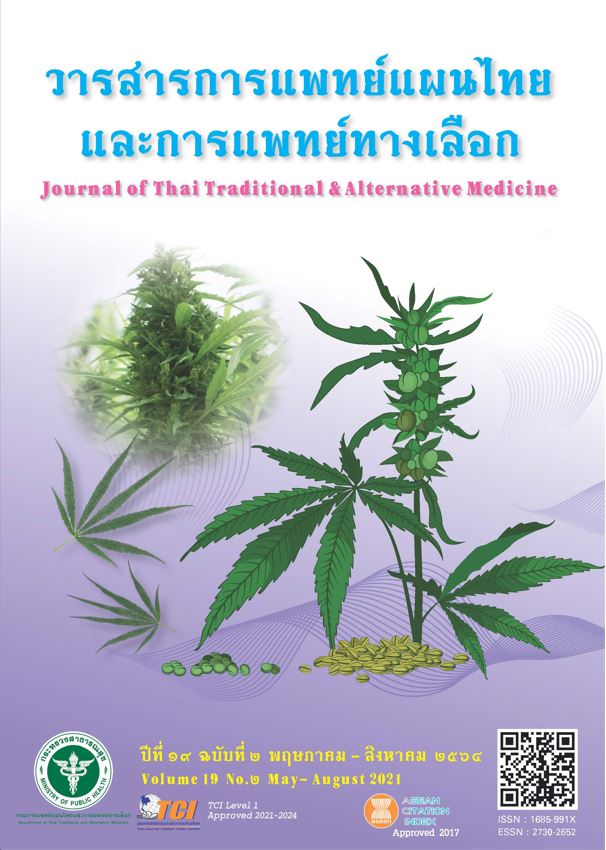Effectiveness of Smoking Cessation Programme Based on Integrative Modern and Thai Traditional Medical Concepts in Patients with Non-Communicable Diseases: A Single-Blinded Randomized Controlled Trial
Main Article Content
Abstract
Effects of smoking cessation on patients with non-communicable diseases (NCDs) were assessed. A smoking
cessation programme was implemented based on the concept of behavior change in NCD patients using modern and Thai traditional medicinal principles by taking care of the body using the principles of natural foot reflexology and herbal medicines including ma-waeng lozenges, ya-dokkhao (white flower) herbal tea and rangjued capsules. In the control group were NCD patients with conventional treatment who did not follow this programme. The study was approved by the Ethics Committee of Human Research, Surat Thani Hospital. A total of 88 NCD patients in Pak Nam Lang Suan Hospital were randomly assigned to two groups: 44 in the experimental group and the other 44 in the control group. The research instruments comprised a questionnaire and the smoking cessation programme. The model of behavior change was applied to stop smoking by integrating modern and Thai traditional medicine. Results indicated that most participants were male and had suffered from hypertension, dyslipidemia and diabetes. Among all participants, 46.30% in the experimental group could stop smoking while 41.70% in the control group could also do so. No significant difference in the effect of smoking cessation was shown between the two groups after the six-month study period (p = 0.68), but 34 patients (44.16%) could successfully quit smoking. The findings showed that the smoking cessation programme, based on the concept of the behavior change model using integrative modern and Thai traditional medical principles, could induce smoking cessation in NCD patients.
Article Details
References
World Health Organization. Tobacco [Internet]. 2017 [cited 2018 Jun 10]. Available from: http://www.who.
int/mediacentre/factsheets/fs339/en/
Bureau of Tobacco Control, Department of disease control. Overview of the survey characteristics: Global adult
tobacco survey, Thailand 2011. Nonthaburi: Department of disease control, Ministry of Public Health; 2011. 280
p.
Thakur JS, Garg R., Narain JP, Menabde N. Tobacco use: A major risk factor for non communicable diseases in
South-East Asia region. Indian Journal of Public Health. 2011;55(3):155-60.
Thripopskul W, Sittipunt C. Efficacy of Vernonia cinerea for smoking cessation in Thai active smokers (thesis).
Department of Internal Medicine, Faculty of Medicine. Bangkok: Chulalongkorn University; 2010. 79 p.(in Thai)
Heatherton TF, Kozlowski LT, Frecker RC, Fagerström KO. The Fagerström Test for nicotine dependence: a
revision of the Fagerström Tolerance Questionnaire. Br J Addict. 1991;86(9):1119-27.
Hongin P, Preechawong S. The effect of motivation program to quit smoking in orthopedic patients. Thai
Journal of Nursing. 2017;66(2):11-7. (in Thai)
Kuwalairat P, Sornkate R, Lertsinudom S. The outcomes of smoking cessation among non-communicable disease patients at community hospitals under the supervision of clinical pharmacist. Isan Journal of Pharmaceutical Sciences. 2015;11(4):83-103. (in Thai)
Chouinard M, Robichaud-Ekstrand S. The effectiveness of a nursing inpatient smoking cessation program
in individuals with cardiovascular disease. Nurs Res. 2005;54(4):243-54.
Boonyawan B, Kaewpan W, Kalampakorn S, Sitdhiraksa N. Effectiveness of a smoking cessation program applying the transtheoretical model for security officer in Siriraj Hospital (thesis). Department of Public Health
Nursing, Faculty of Public Health. Bangkok: Mahidol University; 2012. (in Thai)
Raya P, Benjakul, S, Kengganpanich, M, Kengganpanich T, Lattanand, K. Effects of the smoking cessation
program applying the Transtheoretical model among smokers at Wongwon Sub-district, Kuntung district,
Trang province. Journal of Boromarajonani College of Nursing, Bangkok. 2015;31(2):9-25. (in Thai)
Kleebpratoom P, Benjakul S, Kengganpanich M, Kengganpanich T. Effects of the smoking cessation program
for smokers at Bangkaew Subdistrict, Muangangthong District, Angthong Province. Veridian E-Journal, Science
and Technology Silpakorn University. 2016;3(4):30-43.
Wungmun R, Soiraya N, Meekeaw L, Hungkhuntod J. Study of the effectiveness of counseling motivation
model for behavior modification smoking among clients in the smoking fast clinic Samrong Thap Hospital,
Samrong Thap district, Surin Province [Internet]. 2015 [cited 2018 Jun 10]; Available from: http://drterd.com/
mcmi/news/admin/imapsurin.pdf. (in Thai)
Intarakumhang Na Rachasima S, Rueangrit P, Wannaprasart W. Guideline for behavioral promotion of
decreased and stopped smoking among people in Banbungbaurapet, Tumbon Kwaiyai, Muang district,
Nakhonsawan Province. Journal of Nursing and Health Sciences 2012;6(1):43-51.
Maisto SA, Galizio M, Connors GJ, eds. Drug use and abuse, 4th ed. Belmont, CA, Wadsworth/Thompson
Learning, 2004.
Institute of medicine committee on preventing nicotine addiction on children and youths. Growing up tobacco free: preventing nicotine addiction in children and youths. Washington, DC: National Academy Press; 1994.
Chaijandee P, Lertsinudom S. Clinical outcome of pharmaceutical care for smoking cessation in Chatturat
Hospital. Isan Journal of Pharmaceutical Sciences. 2016;12(3):24-34. (in Thai)
Laakso O, Haapala M, Kuitunen T, Himberg JJ. Screening of exhaled breath by low-resolution multicomponent
FT-IR spectrometry in patients attending emergency departments. J Anal Toxicol. 2004;28(2):111-7.
Cunnington A, Hormbrey P. Breath analysis to detect recent exposure to carbon monoxide. Postgrad Med J. 2002;78(918):233-7.
Jones RT, Benowitz NL. Therapeutics for nicotine addiction. In: Davis KL, Charney D, Coyle JT, Nemeroff C,
editors. Neuropsychopharmacology: the fifth generation of progress. Philadelphia, PA: Lippincott, Williams &
Wilkins; 2002, p. 1533-44.


